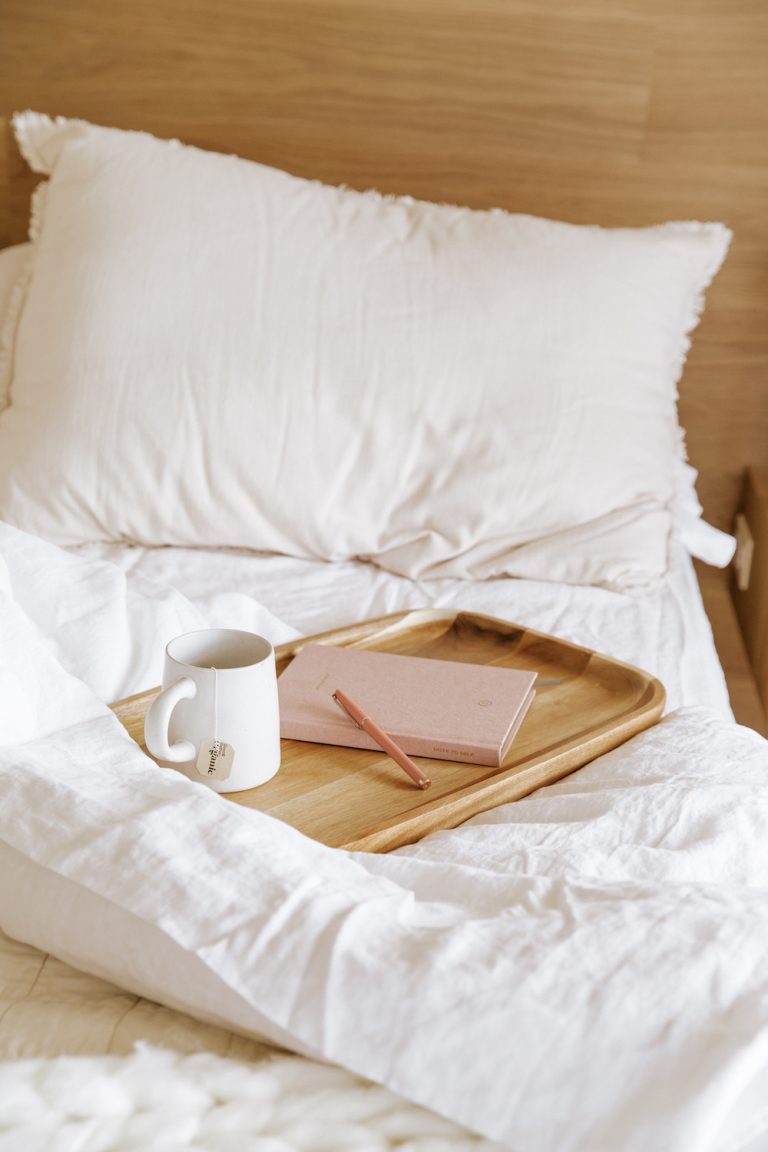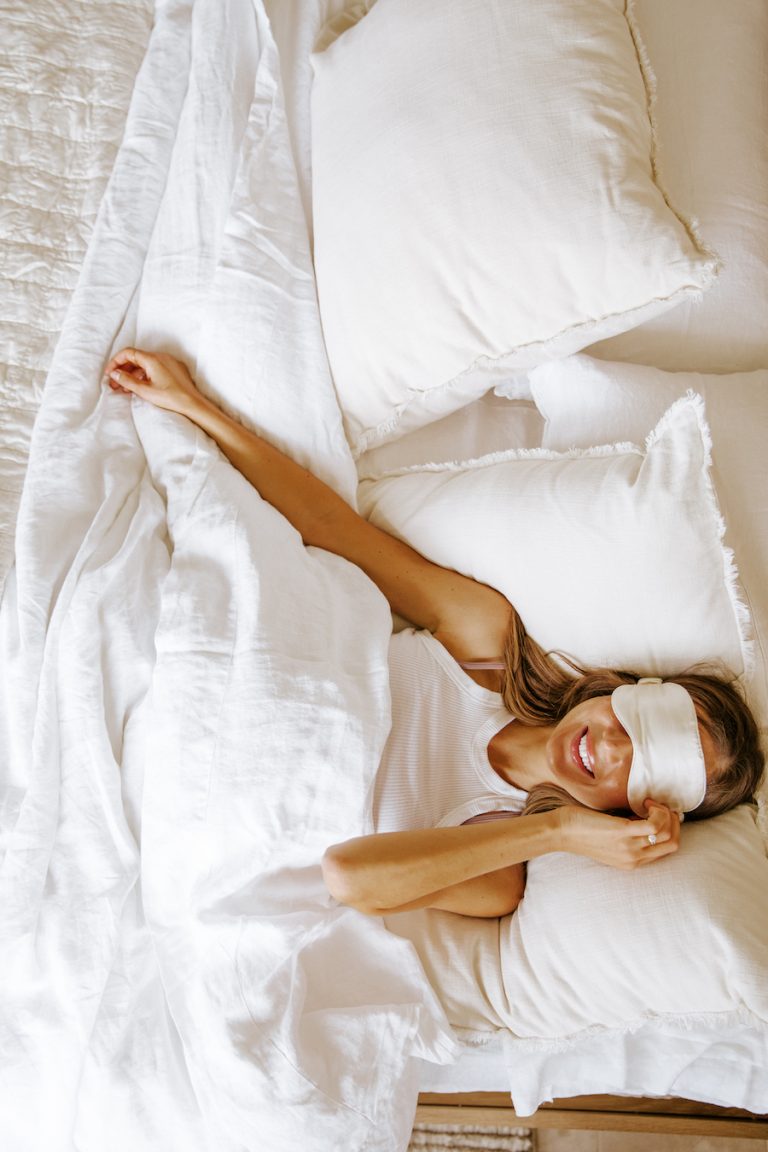
Love a mid-afternoon nap? You’re in impressive company. Margaret Thatcher, Winston Churchill, John F. Kennedy, Aristotle, and Leonardo da Vinci weren’t shy about their afternoon shut-eye. From revolutionary thinkers to astounding artists, these leaders prove that power napping is far from a lackadaisical personality trait. In fact, it might *just be* the secret sauce. Entrepreneurs swear by this unconventional productivity hack—as do clever employers. Because time is of the essence (ahem, my power nap is calling), let’s dive into how to power nap like a pro. Plus, get the secrets for the best sleep of your life.
Feature image by Michelle Nash.

Subscribe
Get Breathing Space
A twice-monthly note from me to you. What's currently on my mind, in my cart, on my plate, and more. Drop your email to subscribe.
Thanks for Signing Up!
Oops!
Looks like you’re already signed up or your email address is invalid.
Oops!
Looks like you unsubscribed before click here to resubscribe.
Why Sleep Is So Important
There’s no denying how important quality sleep is. Our sleep-wake cycle (also known as our circadian rhythm) impacts everything. Think: appetite, blood sugar, metabolism, hormone health, and more. This is no surprise, but most of us aren’t getting enough sleep. Nor, for that matter, are we getting enough sunlight. Thanks to our current lifestyle habits—working at night and being exposed to artificial light before bed—our circadian rhythm is all sorts of disrupted. In turn, this disruption downgrades our overall health and wellbeing. Ultimately, an inconsistent and dysregulated circadian rhythm causes stress on the body. One way to relieve this stress? A power nap.
How the Circadian Rhythm Works
As mentioned, our circadian rhythm influences everything from our eating habits to our body temp, hormone release and digestion. It’s our internal timekeeper. The circadian rhythm maintains our sleep-wake cycle, helping us fall asleep and wake up in the morning. While it differs from a woman’s infradian rhythm (also known as our ‘second clock’), the circadian rhythm deserves just as much love and attention as any other facet of our self-care routine. This rhythm ebbs and flows during the day, but it is best supported by sleep-promoting habits.
7 Tips To Maintain a Healthy Sleep-wake Cycle
When it comes to a healthy circadian rhythm, look no further. The following habits create a nourishing environment for the tiny yet mighty part of the brain that controls our sleep-wake cycle.
1. Get sunlight—especially in the morning
Even if it’s overcast, head outside! Research shows that (bright) morning light can be effective against insomnia, premenstrual syndrome, and seasonal affective disorder. The melatonin precursor, serotonin, is also affected by exposure to daylight.
2. Eat a healthy breakfast within 30-60 minutes of waking
This keeps our blood sugar happy, metabolism revved, and takes the body out of fight-or-flight mode. The energy from what we eat also wakes us up.
3. Incorporate movement throughout the day
Exercise has a myriad of benefits, but it’s also been shown to improve sleep efficiency and duration—in both kids and adults.
4. Keep naps short
5. Avoid caffeine in the afternoon and alcohol before bed
Caffeine can delay the timing of your body clock and alcohol disrupts our sleep architecture.
6. Limit electronics in the evening
Or, be sure to wear blue-blocking glasses. Blue-blocking glasses, specifically, encourage your body to produce optimal melatonin levels close to your desired bedtime. That way, you can fall asleep faster and stay asleep throughout the night.
7. Build a consistent sleep schedule
We are creatures of habit. Routines—including a bedtime routine—offer a way to promote health and wellness through structure and organization. Having a routine can greatly improve your health.
What is a power nap?
Armed with an understanding of why sleep is so important, let’s talk about the ever-coveted power nap. Even if it’s not something you can prioritize during the week (or even in this season of your life), it’s helpful to know what it is, how to implement it, and why it could be a total game-changer. While there’s no medical definition of a power nap, in general, the term refers to short naps ranging from about 10 to 30 minutes. It isn’t long enough to make you groggy or interrupt your sleep cycle—rather, it’s meant to encourage a full-body reset.
What are the benefits of power napping?
Even if you aren’t sleep deprived, a power nap can be beneficial. In essence, they help refill your tank. An efficient (yet effective) afternoon nap has many benefits. If you’re a seasoned power napper, you know the perks. An afternoon nap can help you feel less sleepy and lead to improvements in: mood, alertness, productivity, reaction time, short-term memory, focus, concentration, and more. While there aren’t many cons to power napping, it’s important not to sleep too long during the day. After all, you need to maximize sleep at night.
How long should you power nap for?
Depends, but most agree that over 60 minutes can disrupt your circadian rhythm. Furthermore, studies show that a 10-minute afternoon nap is the most effective in improving alertness and productivity. Many experts advise a 15-30 minute nap, as anything longer gets you into deeper stages of sleep, making it that much harder to wake up. If you’re looking for restorative sleep and have the time to spare, see how you feel with an hour-long nap. Compared to a shorter nap, 60 minutes can lead to greater improvement in cognitive functioning.
All of that said, if you only have five minutes to spare, just close your eyes! A brief rest is better than no rest.
Is power napping for everyone?
The hard truth: power napping might not be for you. Be it your work schedule, parenting responsibilities, or the stress it causes (because you’re ruminating over your to-do list), consider a different reset activity. Rather than napping, you may reap the benefits of a brisk walk, a minute of squats and pushups, or brewing a cup of calming tea. Furthermore, if you tend to wake up feeling disoriented—or more tired than before the nap—focus on clocking your zzz’s at night.
How Power Napping Boosts Productivity
A study conducted by the National Sleep Foundation found that a 40-minute nap improves productivity by 34%. Relatively speaking, that’s not a small percentage. Are you an employer? If so, consider how a power nap could work its way into your company’s handbook. With sleep deprivation negatively influencing the global economy—and studies showing that instituting sleep-friendly policies can improve productivity by over 30% (and alertness by up to 100%!)—allowing employees to rest in the workplace is a win-win. A power nap could drastically change your workplace and directly influence profits. You heard it here first.
Napping During the Workday
Speaking of napping at work, did you know that a weekday nap is encouraged in countries around the world? For example, there is the tradition of the siesta in Spain. In China, people take an hour break midday to rest. In Japan, inemuri means napping while present, and is seen as a sign of hard work. In the United States, the CDC recommends dedicated physical space—as well as scheduling—to allow for napping. Many organizations have already incorporated nap rooms into their offices. Google, NASA, and Ben & Jerry’s support napping by providing specific spaces like “napping pods” for their employees.
4 Steps to Becoming a Power Napper
Ready to take the perfect power nap and wake up feeling refreshed? Follow these four rules to get the most bang for your power nap buck.
- Get the time right. The circadian rhythm is low between 2-4 p.m. To improve your alertness, productivity, memory, and function, aim to take your nap in the early-to-mid afternoon. There are many activities you can do to beat the afternoon slump, but a quick power nap could be the golden ticket.
- Recharge with the ideal duration. One of the keys to successful power napping is its length. Too much takes you into deep sleep mode, leaving you tired and groggy afterward. Too little is not enough. Experts explain that the maximum power nap recharge is achieved by going from stage one sleep (that lovely ‘drifting off’ feeling) to stage two (slowdown of brain activity). In most people, that’s 15-30 minutes.
- Create a dark environment. Just like ideal nighttime sleep comes from a cold, dark room, so does your afternoon nap. Wear this silk eye mask and thank me later. If necessary, pop in ear plugs. The fewer intrusive sounds, the better.
- Turn your phone on ‘Do Not Disturb.’ Because we all know how easy it so to get distracted by messages, alerts, etc., block your calendar during nap time and silence your messages. Trust that you can clock 15-30 minutes of rest without tending to other people’s needs. In fact, I bet you’ll tend to their needs with extra enthusiasm after your power nap.
The post Power Nap Like a Pro—8 Tips To Getting the Energy and Rest You Need appeared first on Camille Styles.









0 Comments